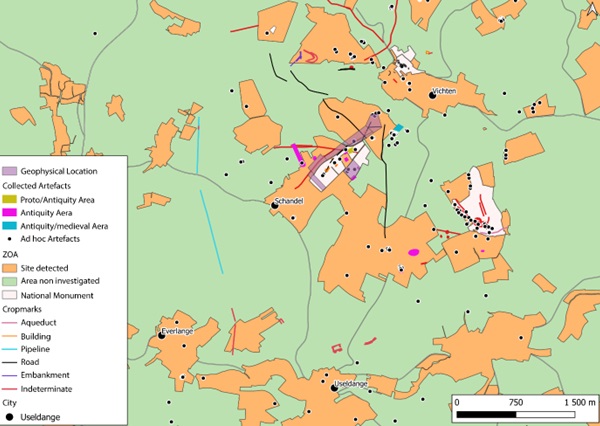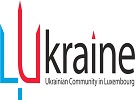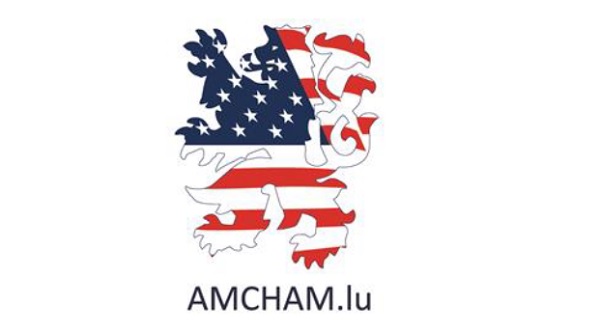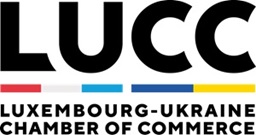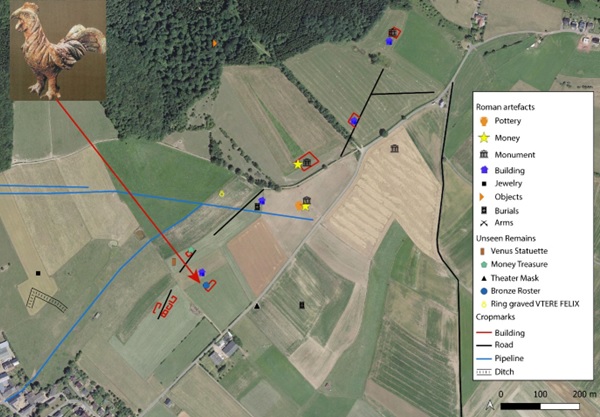 Aerial view showing most of the Roman archaeological structures and object finds. The bronze rooster artefact appears to have been found inside a building;
Credit: GIS - Di Liberto, map under construction
Aerial view showing most of the Roman archaeological structures and object finds. The bronze rooster artefact appears to have been found inside a building;
Credit: GIS - Di Liberto, map under construction
Chronicle.lu has teamed up with Luxembourg's National Institute for Archaeological Research (Institut national de recherches archéologiques - INRA) for a series of articles on archaeological digs and discoveries around the Grand Duchy.
The series explores digs spanning from prehistoric to Roman and medieval times, highlighting key finds and what they reveal about Luxembourg’s past. It also sheds light on the work of the INRA and its approach to archaeological and historical research.
The latest article in this series looks at Roman-era discoveries in Schandel and Vichten.
In the west of Luxembourg lies Useldange, where the town’s imposing castle dominates the landscape. Thanks to excavations carried out within the castle a few years ago, archaeologists now know that it has existed since at least the 8th or 9th century AD. However, questions remain about the reasons for constructing such a castle in this particular location during that period - prompting a look further back, to the Roman era. Archaeologists have discovered evidence of significant occupation predating the castle, near Useldange, in the present-day localities of Vichten and Schandel, just two kilometres apart. (For more on the castle, see https://chronicle.lu/category/history-archaeology/56298-archaeology-in-luxembourg-useldange-site)
Numerous discoveries have been made in this region over several decades, often during construction work, road modifications or changes to agricultural fields, as well as when new houses were built. At the same time, local history enthusiasts began conducting their own research in the area. For example, Robert Steichen, a former historian, carried out excavations on a plot in Vichten where the foundations of a presumed Roman temple were visible.
Meanwhile, another passionate resident of Vichten conducted extensive field surveys, unearthing a wide variety of objects, some of which had been previously undocumented. Over the past 30 years, he has continued cataloguing his finds, contributing valuable data to current understanding of the region’s past.
The most important archaeological discovery highlighting the significance of the Roman occupation in this area is the Roman villa of Vichten and its famous luxury mosaic, widely known among researchers. Discovered in 1995 during the construction of a farm building extension, a worker reported the find to the Centre National de Recherche Archéologique (CNRA, predecessor of today's INRA). Excavations began shortly thereafter, under the supervision of archaeologist Dr Jean Krier.
This exceptional villa quickly became a reference site in Luxembourg, with its mosaic (see below) and painted plasterwork now exhibited at the National Museum of History and Art in Luxembourg City.
A few years later, thanks to surveys conducted by Romain Jacoby, a major treasure was discovered in Schandel, just one kilometre from the villa. Excavations, once again led by Dr Jean Krier, were carried out. Yet this was not the only discovery in the area. Schandel gradually began to reveal more of its secrets: aerial surveys identified at least six buildings precisely where unique objects had been found (see main photo).
Several years later, a pipeline installation crossed through the same landscape, prompting archaeological monitoring ("suivi de travaux"). This led to the excavation of a Roman burial site.
All these discoveries confirm the presence of significant Roman occupation between Schandel and Vichten. However, due to a lack of systematic investigation, much remains unknown about the full extent and organisation of this ancient site.
To address this, a major geophysical survey covering at least 15 hectares was launched last year. The results are currently being analysed, and researchers hope they will soon provide new insights.
While previous excavations and surveys were often ad hoc and did not follow a structured form, the INRA has now undertaken a systematic study of all past finds and material. These are now being systematically studied and cross-referenced, notably through a Geographic Information System (GIS), to help researchers better understand and protect this important archaeological landscape (see below).
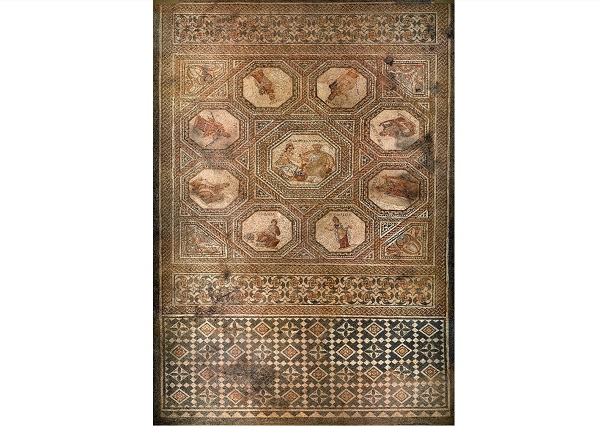
The mosaic from the Roman villa of Vichten; Credit: Licence Creative Commons
